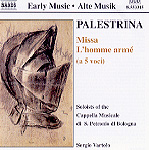The 15th-century secular song “L’homme armé”, a paean to military readiness, was widely used as a cantus firmus by composers as diverse as Josquin, Ockeghem, and Dufay. Palestrina found “L’homme armé” so compelling in fact that he wrote two mass settings using this melody. (The four-voice setting also has been recorded by Sergio Vartolo and his singers for Naxos.) Hearing Palestrina’s settings is an all-too-rare opportunity, though, and so this recording does hold genuine interest, regardless of its flaws.
The performances are less than ideal on a couple of major counts. The conductor contends that there are sources indicating the usage of organ continuo, and the inclusion of that instrument (played by Vartolo himself) is a choice that some listeners may find either musicologically troublesome or at the very least aesthetically distracting, especially considering the innate intimacy of this small-ensemble music. (I’m only addressing the latter issue here; I’ll leave the matter of appropriateness to Palestrina scholars.) On the one hand–and here’s the questionable virtue of Vartolo’s decision–the organ’s solidity creates a badly needed core to this performance, bolstering what often is bloodless singing. (The beautifully sculpted Credo is an exception.) The flip side of that coin is that the organ becomes a real focal point rather than a subtle addition. The instrument’s centrality is further amplified by Vartolo’s decision to break up the Mass’ sections with four ricercares by Palestrina’s contemporary Girolamo Cavazzoni, a practice that is meant to mimic performance practice of the day. The sound lacks vibrance; it’s necessary to crank up the volume quite a bit to achieve any semblance of brightness.
































